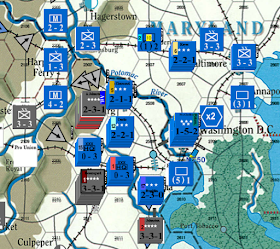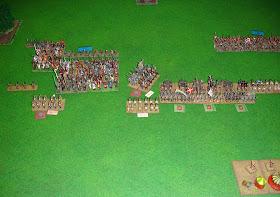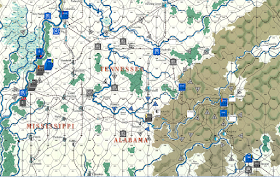The cycle that could have seen a Confederate victory instead sees a horrid compounding defeat.
The Union carryforward 30 supply and add to it 190 plus 28 from captured towns (after accounting for the loss of Harper's ferry - rail line is blocked by Confederate zone of control); that's a total of 248 for 10 personnel points.
The Confederates carry forward 126 plus 60 from major cities, a mere 2 from import supply and 61 from towns. A total of 249 for 60 personnel points - the Confederates have implemented the draft. This gives the Union 3 political points.
The Union augment a 3-3 to a 10-3, convert a 3-2 to a 3-3 and build a railway repair unit. This leaves 171 supply.
The Confederates augment four 3-3s to 10-3s, build a railway repair unit, an ironclad and raise 14 militia. They are left with 69 supply.
Buell does his best to reorganise his army by amalgamating brigades with divisions, his army is so battered he is able to do four of these - what was once an 8 division strong army is now 4 divisions.
The Union deploy a 3-3 to St Louis along with a River Flotilla and an ironclad. 10-3s go to Cairo, Evansville and Washington. A 3-3 goes to Cincinnati and 4-3s to Philadelphia and Baltimore. A 2-4 goes to Washington. Lyon returns to the work and is joined by McCook and Franklin. They go respectively to Baltimore, Cairo and Washington. Each has a corps. Lyon has requested a seaside posting to aid in his convalescence. The Department of the South is created in Bowling Green, KN.
2,000 Union militia decline further service.
The Confederates deploy 8-3 divisions to Richmond and Raleigh. Longstreet returns and is placed in charge of a corps in Raleigh. There are no partisans although a cadre is formed in Virginia. Jackson's plans to build a fort at Fort Pillow to further protect Memphis are delayed.
Union supply consumes 53 using 12 rail leaving them with 118 and 28 rail. They take the opportunity with this surplus to top up their depots and supply wagons.
The Confederates require 31 supply and 8 rail which leaves them with 38 and 17 rail. That's the good news. 55,000 men surrender to General Keyes outside Baltimore, there has never been a more dejected looking set of captives. A further 51,000 men are isolated with Johnston on the Potomac. The loss of the Corps HQ with the surrender gives the Union a political point.
The survival of Johnston depends on the Confederates getting to move first.
Week 61
The Union draw the 1 chit.
The Confederates tell Johnston to get out of there. He needs no encouragement. The supply train has to be abandoned as the army heads to the mountains.
Van Dorn is ordered to send a brigade to cut the rail line supporting the Union offensive directed at Atlanta.
Longstreet rails to Richmond with his division.
Bruckner liberates Jacksonville.
Jackson attacks Buell on the 131-160 column of CRT 4. Jackson uses two supply. Both sides lose 15% which is 7,000 men for the Confederates and 5,000 for the Union. Buell is wise to stay back at army HQ as he again avoided becoming a casualty. The Union retreat. Jackson doesn't follow.
The Union tell Crittenden to clear the Confederates off the railway line that is causing consternation to Halleck's Atlanta offensive. He succeeds, although the rebels still block the line as far as Halleck is concerned and a 1,000 men and much supplies were lost in making this backwards move. Pope, Banks and Halleck all wait on Crittenden.
Sumner stays in Springfield, MO. McCook, Buell and Pleasanton all stay put on the banks of the Mississippi; the fish must be biting.
Hooker captures Tallahassee and cuts the rail line to Jacksonville, FA, this makes Buckner's liberation of that town of limited use.
In North Virginia, McClellan fails to stir, exhausted by writing his victory speech. Porter also doesn't move, but Curtis has the sense to send him some reinforcements from McClellan's army. Keyes and McClernand are slow to move and Franklin is still being measured for his uniform. That leaves the newly returned Lyon.
Not to disappoint, Lyon takes 14,000 men and supplies in a large fleet of naval transports and river transports to Hampton and then marches up to confront Hindman. He attacks on the 251-400 column of CRT 4. Both sides lose 2,000 men and the Confederates retreat.
Porter should attack. He has a good chance of being able to cut Johnston off if he can force Magruder out of the way. But he doesn't...
Week 62
The Union get the 4 chit.
McClellan is told to stop Johnston from attacking. He orders Porter to march attack Beauregard. With 8,000 cavalry Beauregard would prefer to retire, but knows he must stand and fight. Both sides lose 1,000 men, but the Confederates hold. Seeing this McClellan reinforces Curtis and Porter and wonders if they, later, maybe, will just possibly attack.
Franklin is sent forward as is McClernand.
Crittenden is told to try again to dislodge the Confederates blocking the rail line. His march attack inflicts 1,000 casualties on the Rebels, but they do not budge (they are in rough terrain and could avoid retreating even if that was the result he achieved).
Halleck stares at Atlanta and wonders what to do. Grant (his apprenticeship now finished) slips out from under him and goes and joins Crittenden. Banks goes back to Nashville. Pope wishes he knew what to do. Later Grant doesn't even break a sweat (or risk himself) in removing the Rebel roadblock in east Tennessee.
The Mississippi generals keep fishing.
Hooker captures Chattahoochee and the fort covering the mouth of the eponymous river. This river gives a back door way to Atlanta.
Lyon, proving every bit adept as Hooker in striking where the Confederates are not, slips back to Hampton, but this times boards a river steamer and descends on Petersburg.
Keyes is still busy processing all the Confederate prisoners.
Porter attacks Magruder on the 251-400 column of CRT 3. The Union use 2 supply inflicting 4,000 casualties on the Confederates and forcing them to retreat. However they lose 5,000 men including Porter, shot through the head. Magruder is wounded and will be out of action for 7 months.
Can Johnston escape?
Johnston tries a march attack to break out (71-90 column of CRT 1). He succeeds, but as he leads his men out of the trap he is shot dead by a Confederate picket who mistakes him for one of those damn Yankees. Whoops! At least there is Breckinridge to take command.
Beauregard and Bragg (mislabelled as Johnston on the counter) sit tight. Longstreet must do the same in Richmond as there are not enough troops to defend the capital and engage Lyon.
The Confederates realise they need some supplies in Atlanta if they are going to be able to fight back.
Van Dorn turns round and liberates Florence, but it costs him 1,000 men.
Jackson leaves Hardee in charge and takes 11,000 crack infantry to go and join Van Dorn and confront Grant.
D Hill, Huger and Polk do nothing, this might be okay for Polk, but the other two were supposed to send Jackson some supplies. Instead Hardee sends his supply train to Jackson.
Buckner is shocked by Hooker's actions in Florida and doesn't know what to do.
The loss of Florida
It is big out west
Week 63
The Union get the 1 chit. This means a back to back move for the Confederates.
Beauregard sends troops to reinforce Bragg and also a small division back to the Richmond environs. Breckinridge leads the Army of the Atlantic to join Beauregard outside Manassas.
D Hill is ordered back East. The Confederates are a tad short of generals. He has to change trains and gets as far as Greenville, AL.
Hardee, now with a supply train sent by Hill, stays at Fort Pillow. His numbers match Buell's at around 26,000. Polk stays at Little Rock and Huger takes command of Memphis.
Jackson rails his supply train to Van Dorn and then force marches after it, arriving safely and building the force up to 23,000. Van Dorn just waited for him.
Floyd sleeps soundly in New Orleans, Buckner worries in Florida and A Hill stares at Halleck, trying to make him go away from from Atlanta.
Hindman, who was down to just 2,000 men, is reinforced by Longstreet.
The Confederates, with the successful escape of poor Johnston's army, now have over 70,000 men north of the Rappahannock. The Union have 117,000 south of the Potomac and over 40,000 north of the river.
McClellan leaves Washington, where rumours that he was plotting a coup turn out to be untrue, fake news not having yet been invented. He takes the Army of Potomac HQ to command poor Porter's leaderless corps.
Curtis and McClernand wonder what to do next. Franklin sits secure south of Alexandria. Keyes starts an offensive in the Shenandoah Valley. He captures Winchester and the Confederate garrison flees, losing 2,000 men.
Lyon with his 9,000 men marches to attack the naval base at Norfolk, leaving 1,000 men to destroy the railroad at Petersburg and then force march to join him in his assault. The base surrenders (it was forced to retreat which I interrupted as eliminated).
Hooker contemplates his next move: should he go up the Chattahoochee?
Halleck wonders if he should march down and meet Hooker, but he doesn't.
Grant tells Crittenden to stay put while he goes to get reinforcements (he goes to Nashville and catches a train to Bowling Green).
Banks rests up in Nashville. Pleasanton stirs into action and heads south capturing Humboldt and Jackson. McCook sends reinforcements to Buell, although a 1,000 are lost on the way. He then heads to Bowling Green along with some militia sent by Pleasanton on a paddle steamer.
Sumner does nothing in Missouri.
Week 64
The Union scrape in with the 2 chit.
Longstreet organises the reoccupation of Petersburg, but the damage has been done, however they can organise if enough water transport to keep it functioning as a supply town.
Beauregard decides to stay north of the Rappahannock and sends 5,000 men to reinforce the valley. D Hill continues his journey east arriving in Raleigh, but too late to get a hotel so he sleeps in his train carriage.
Buckner remains mystified in the Florida swamps.
Jackson goes to Athens taking every available man except Van Dorn who is abandoned in Florence. Hardee thinks about going and trying to get Jackson back, but decides he better stay and protect Memphis.
All the other learned Confederate generals write letters to President Davis saying how they would have won the war by now if only they had been put in charge of the Army of Northern Virginia. The Confederate President only wishes he still had an Army of Northern Virginia.
The Union full strength division that was marooned at Evansville is railed to Bowling Green.
Pleasanton is then instructed to conduct a devastating raid.
Pleasanton has 8,000 troopers in three divisions.
- First the 2,000 strong division goes to Florence, capturing Van Dorn and liberating that town.
- Then one division splits off a brigade which goes via Corinth to the rendezvous point south of Florence.
- The remaining division then splits off a brigade that goes to Corinth, destroys the rail line and heads to the rendezvous point.
- Finally Pleasanton takes the remaining 4,000 men to the meet the others, putting them all in command and able to trace supply via Savannah.
The forced march via the red path (2 extra in unfriendly territory) resulted in the loss of 1,000 men (there was no risk of losing more). The forced march on the blue path (1 extra in enemy territory) resulted in the loss of 1,000 men, but meant the black path was 2 extra in now friendly territory and had no losses while the yellow path (just 1 extra in friendly) also lost 1,000 men. Rather expensive, but losses could have been less (as it was they were the maximum as if the whole 6,000 had done the black path - 2 extra in enemy - the maximum loss would have been 25%).
The capture of Van Dorn and his corps (even though it was empty) gives the Union a political point and cutting the railway at Corinth puts Jackson out of supply.
Buell fails to move, but Banks does, recapturing Pulaski, which would really infuriate Jackson.
Grant sends 10,000 men to Nashville, but remains behind in the Department of the South at Bowling Green. Crittenden is to stay put. Halleck decides to as well.
Hooker returns to Tallahassee so he can keep an eye on Buckner.
Lyon rests up in Norfolk, as does Keyes in Winchester.
Curtis crosses over to support McClellan in an expected attack, but one is not forthcoming.
If the Union push up the valley, they will be able to turn the Confederates' flank
Compared to the compactness of the east, the west is wide open spaces.
Casualties
The Union lost 15,000 compared to the Confederates' 17,000 plus 55,000 surrendered.
























































